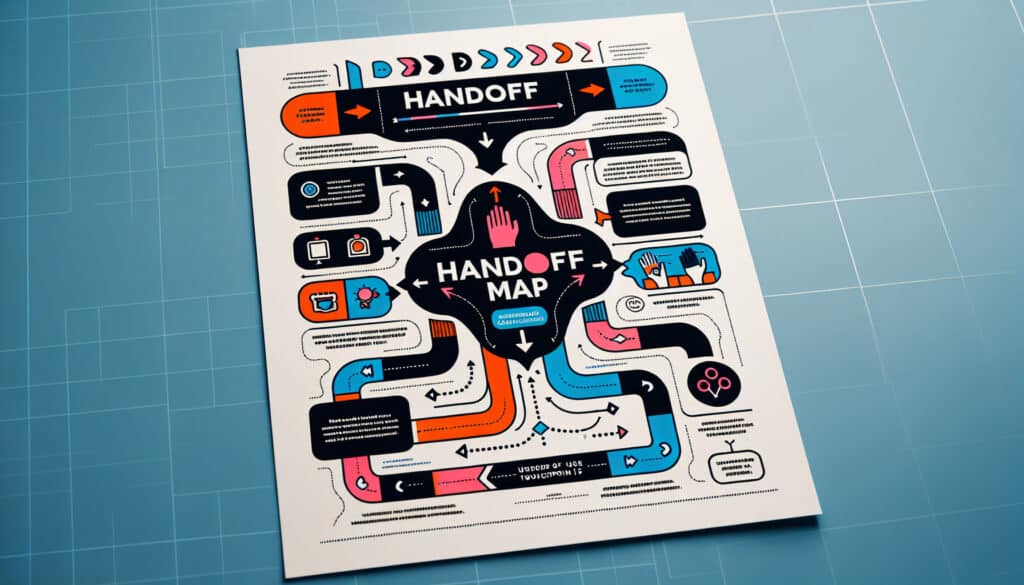To visualize and analyze the handoffs between different touchpoints in a user journey.
- Metodologías: Clientes y marketing, Lean Sigma, Diseño de producto
Mapa de transferencia

Mapa de transferencia
- Mejora continua, Experiencia del cliente, Trayectoria del cliente, Pensamiento de diseño, Mapeo de procesos, Diseño de servicios, Experiencia de usuario (UX), Diseño centrado en el usuario, Propuesta de valor
Objetivo:
Cómo se utiliza:
- A diagram that shows the points where a user moves from one channel or touchpoint to another, such as from a website to a call center. It is used to identify potential points of friction and improve the user experience.
Ventajas
- Helps to identify and address pain points in the user journey; Improves the consistency of the user experience across channels.
Contras
- Can be complex to create and maintain; May not capture all the nuances of the user experience.
Categorías:
- Clientes y marketing, Diseño de producto
Ideal para:
- Improving the user experience of a multi-channel service like online banking or retail.
A Handoff Map can be particularly beneficial in industries that rely on seamless integration across various channels, such as telecommunications, healthcare, and customer service operations. In the product development phase, especially during user experience design, teams can utilize this methodology to visualize the interaction pathways of users as they switch from one service touchpoint to another, like moving from a mobile app to an in-store experience. This is particularly important for sectors where customer satisfaction is paramount, as it facilitates the identification of areas where transitions may cause confusion or frustration, allowing designers and engineers to proactively address these concerns. Participants typically include user experience designers, product managers, customer service representatives, and stakeholders who advocate for the customer perspective, ensuring that all channels provide consistent messaging and functionality. By pinpointing friction points or disconnects within the user experience, organizations can develop targeted improvements, ultimately leading to higher customer satisfaction, increased retention rates, and reduced service costs. Such an approach also fosters collaboration across different departments, enhancing communication and leading to a more integrated service offering for users interacting with diverse channels.
Pasos clave de esta metodología
- Map out all existing user touchpoints across channels.
- Identify user paths between each channel and touchpoint.
- Evaluate transition points for potential friction.
- Assess the consistency of information and experience across channels.
- Prioritize touchpoints based on impact and frequency of use.
- Develop solutions to address identified pain points.
- Implement enhancements and iterate based on feedback.
Consejos profesionales
- Conduct regular usability tests specific to each channel to uncover friction points not evident in analytics.
- Integrate a feedback loop across channels, ensuring insights from customer interactions inform enhancements on all touchpoints.
- Utilize journey analytics to track transitions between channels, enabling data-driven decisions on where improvements should focus.
Leer y comparar varias metodologías, recomendamos el
> Amplio repositorio de metodologías <
junto con otras más de 400 metodologías.
Sus comentarios sobre esta metodología o información adicional son bienvenidos en la dirección sección de comentarios ↓ , así como cualquier idea o enlace relacionado con la ingeniería.
Contexto histórico
1986
(si se desconoce la fecha o no es relevante, por ejemplo "mecánica de fluidos", se ofrece una estimación redondeada de su notable aparición)

Publicaciones relacionadas
Calculadora de METS a calorías
Metaanálisis
Asignación de mensajes
Diagramas de modelos mentales
Fuerzas de empuje y tracción máximas admisibles
Planificación de necesidades de material (MRP)